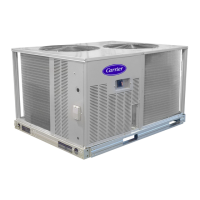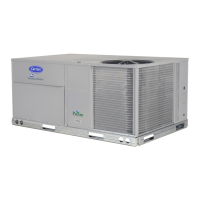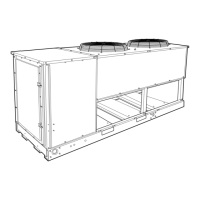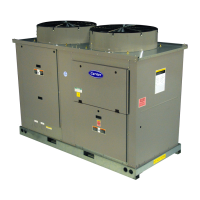28
MAINTENANCE
These items should be part of a routine maintenance program, to
be checked every month or two, until a specific schedule for each
can be identified for this installation:
Quarterly Inspection
(and 30 days after initial start)
INDOOR SECTION
• Condenser coil cleanliness checked.
• Return air filter replacement
• Outdoor hood inlet filters cleaned
• Belt tension checked
• Belt condition checked
• Pulley alignment checked
• Fan shaft bearing locking collar tightness checked
• Condensate drain checked
Heating
• Power wire connections
• Fuses ready
• Manual-reset limit switch is closed
Seasonal Maintenance
These items should be checked at the beginning of each season (or
more often if local conditions and usage patterns dictate):
AIR CONDITIONING
• Condenser fan motor mounting bolts tightness
• Compressor mounting bolts
• Condenser fan blade positioning
• Control box cleanliness and wiring condition
• Wire terminal tightness
• Refrigerant charge level
• Evaporator coil cleaning
• Evaporator blower motor amperage
Economizer or Outside Air Damper
• Inlet filters condition
• Check damper travel (economizer)
• Check gear and dampers for debris and dirt
See Tables 16 and 17 for unit specific maintenance checklists.
Table 16 — Outdoor Unit Maintenance Checklist
MAINTENANCE CHECKLIST
a
a. The above list may not include all maintenance items. Inspection intervals may
vary depending on climate and opening hours. Consult your Carrier dealer
about a service contact for seasonal inspections.
RECOMMENDED
INTERVAL
b
b. Monthly maintenance items and outdoor unit rinsing may be performed by the
customer. All other maintenance items and all service work must be performed
by a qualified service technician. Read all warning labels.
Outdoor unit specific: Monthly Annual
Clear away debris and vegetation near unit. X
Inspect cabinet for damage. Replace
components that are damaged or severely
rusted.
X
Inspect electrical disconnect for proper
function. Repair or replace as necessary.
X
Inspect electrical wiring and connections.
Tighten loose connections. Inspect and
perform functional test of equipment as
needed to ensure proper function. Repair or
replace damaged or overheated components
and wiring.
X
Check refrigerant system subcooling and
superheat.
X
Inspect inside of unit. Clean if debris is
present.
X
Inspect condenser coil. Clean if dust, dirt, or
debris is present. Rinse unit with fresh
water.
c
c. Do not use harsh chemicals or high pressure water on coils. More frequent rins-
ing is required near a sea coast.
X
d
d. Monthly rinsing of the condenser coil is recommended if the unit is located in a
corrosive climate.
Inspect motor and fan for damage. Make
sure fans spin freely.
X
Table 17 — Indoor Unit Maintenance Checklist
MAINTENANCE CHECKLIST
a
a. The above list may not include all maintenance items. Inspection intervals may
vary depending on climate and opening hours. Consult your Carrier dealer
about a service contact for seasonal inspections.
RECOMMENDED
INTERVAL
b
b. Monthly maintenance items and outdoor unit rinsing may be performed by the
customer. All other maintenance items and all service work must be performed
by a qualified service technician. Read all warning labels.
Indoor unit specific: (for accessories
refer to unit specific literature)
Monthly Annual
Inspect, clean, or replace air filter if dirty. X
Inspect and clean blower assembly (includes
blower housing, wheel, and motor).
Lubricate shaft bearings.
X
Inspect internal and external cabinet. Clean
as needed.
X
Inspect electrical disconnect for proper
function. Repair or replace as necessary.
X
Inspect electrical components, wiring, and
connections. Tighten loose connections.
Repair or replace damaged components and
wiring.
X
Inspect evaporator coil. Clean if dust, dirt, or
debris is present.
c
c. Do not use harsh chemicals or high pressure water on coils. More frequent rins-
ing is required near a sea coast.
X
Clean condensate pan, trap, and drain lines
(more frequent maintenance may be
required in humid climates - consult your
local HVAC dealer).
X
Inspect motor and fan for damage. Make
Inspect airflow system (ductwork). Check for
leaks and repair as needed.
X

